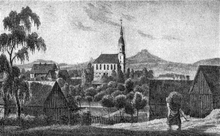Oberoderwitz Church
The Oberoderwitz Church is one of the two village churches in the Oderwitz community . It belongs to the Evangelical Lutheran parish of Oderwitz-Mittelherwigsdorf and was built in the early 19th century in the classicism style.
history
Until 1819, the old church of Oberoderwitz stood in the cemetery opposite today's church. This was probably built in the 15th century, expanded in the 17th century and repaired in 1716. However, since the church was very low and narrow, it no longer offered enough space for the growing parish. Even before the Seven Years' War an extension or a new building had been planned. In 1815 it was decided to build a new church elsewhere.
The plans for the new building were provided by the architect and Zittau council building director Carl Christian Eschke . Construction began in 1816 and the foundation stone was laid on June 3, 1817. The consecration of the church was celebrated on November 7, 1819. The tower of the church was only started in June 1820 and completed with the erection of the tower head on October 22, 1821. The old church was demolished from 1817 to 1819 and the wood was used for the new building. In 1844 the wooden floor of the church was replaced with stone slabs due to sponge infestation, and in 1860 the altar space was also covered with stone slabs. The tower dome was renewed in 1874. The roof of the church was completely renewed in 1993.
building
The foundation walls of the hall church form a rectangle of 42 by 19 meters, the interior has three galleries and is illuminated by seven windows on the long sides and three on the narrow sides. The sacristy was placed in a corner under the gallery behind the altar . The galleries are supported by pillars decorated with palmettes and with wreaths of leaves at the top. The tower merges into an octagon in the middle and has a slightly curved hood. The exterior of the church is kept simple, there is only a belt cornice to cover the door and a main cornice around the tower. There are smaller rectangular windows underneath the belt and large arched windows above.
Investments
The grounds of the churches include a rectory and a church school, in whose building the Royal Saxon court organist Gustav Adolf Merkel was born. In the four cemeteries of the community there is also a grove of honor for those who died in the two world wars .
Furthermore, the Luther House is one of the facilities of the church. It is located east of the church and was built as a children's home in 1914 before being converted into a community center in 2006.
Furnishing
Altar and pulpit
The first altar and the first pulpit came from the old church, but were replaced around 1860 by new pieces based on designs by the architect and Zittau building director Carl August Schramm , a student of Karl Friedrich Schinkel . The altarpiece shows Christ blessing his disciples. It was painted by Carl Gottlob Schönherr from Dresden and given to the church by the Saxon Art Association .
organ
The early romantic Oberoderwitz organ was built in 1821 by Johann Gottfried Müller from Neugersdorf and equipped with two manuals and 30 voices. It was inaugurated in 1824 and given a stately housing in 1839. With its dimensions, it was one of the largest organs in Upper Lusatia , which is remarkable because at the time of the Napoleonic Wars of Liberation, mostly only smaller organs were built. In 1884 a third manual with seven registers was added to the organ and the old fan was replaced.
The tin prospect pipes were melted down for war purposes in 1917 and later replaced by zinc pipes with an aluminum bronze paint finish.
From 1949 to 1950 the organ was fundamentally rebuilt. From then on the organ had 35 registers, the sound character was changed by the reconstruction of the substation, the sound was now a slimmer, sharp and borrowed from the north German baroque organ construction . In addition to the tonal change, the organ's mechanics were also changed.
The organ, like others, was severely damaged by the long and hot summer of 2003. Many of the leather and wooden parts are so badly damaged that the organ has not been used since that time.
Bells
The old bell of the church consisted of two bells, which were melted down by Friedrich Gruhl in 1823 in the Kleinwelka bell foundry . A ring of three bells with a tuning in E flat major was cast from the material.
In 1942 and 1947, however, these bells were also removed in order to melt them down for war purposes. They were replaced by a chill-cast iron bell in F sharp major from Schilling & Lattermann , which was consecrated on May 21, 1947. Shortly afterwards, however, the old bronze bells were rediscovered in the Hamburg bell cemetery and again replaced the chilled cast iron bells in the spring. The bells were overhauled in 2001.
literature
- Moritz Oskar Sauppe : The Diocese of Löbau . In: New Saxon Church Gallery . Strauch, Leipzig 1908 ( digitized version [accessed on May 10, 2010]).
- Cornelius Gurlitt : Administrative Authority Löbau . In: Descriptive representation of the older architectural and art monuments of the Kingdom of Saxony . Meinhold, Dresden 1910 ( digitized [accessed on May 10, 2010]).
Web links
Individual evidence
- ↑ http://www.kirche-oderwitz-mittelherwigsdorf.de/
- ^ Herbert Feurich: From the local history . In: Oderwitzer Nachrichten - Official bulletin of the community of Oderwitz . No. 1 , 2011, p. 7 ( digitized version [accessed on May 26, 2011]).
Coordinates: 50 ° 58 '17.9 " N , 14 ° 42' 4.4" E





